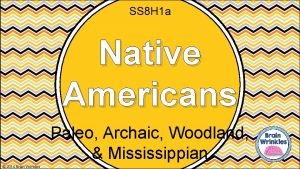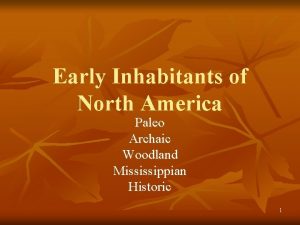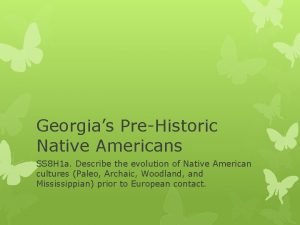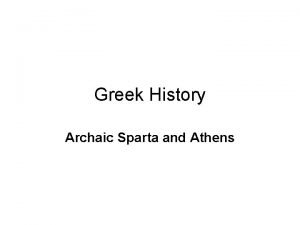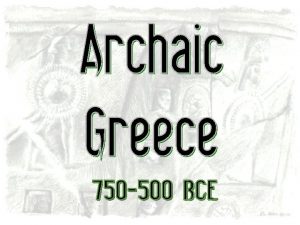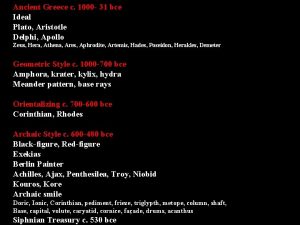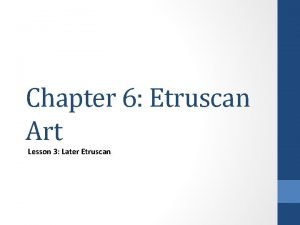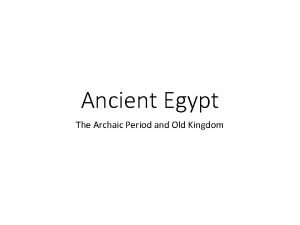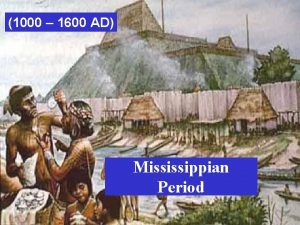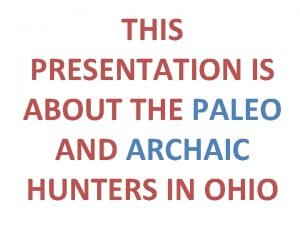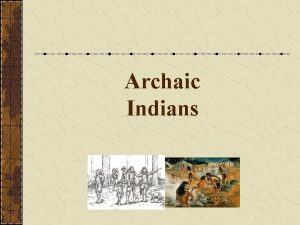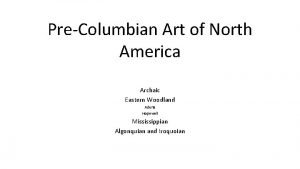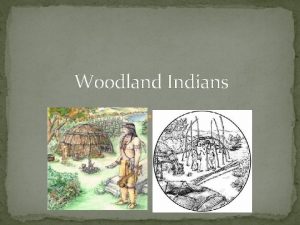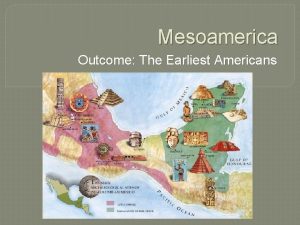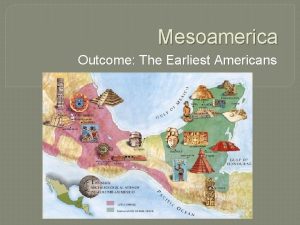PAWM Paleo Archaic Woodland Mississippian The Earliest People














- Slides: 14

PAWM Paleo, Archaic, Woodland, Mississippian

The Earliest People Before systems of writing were developed, history was passed down through oral tradition (older members of families passing down stories to younger generations). Have you experienced something like this in your family?

Discussion How can we learn about people that came before us if there is no written history? Discuss with a shoulder partner and write your answer on a sticky note. Post the sticky note on the board.

The Earliest People We learn a lot about ancient peoples by studying artifacts (pottery shards, weapons, tools, jewelry, or any item made by people). Archaeologists are people that study the past through material remains.

The Earliest People Anthropologists use these artifacts along with cave drawings, well-travelled pathways, and oral history to study the culture of a group. What is culture to you?

The Earliest People Culture is a term that describes the beliefs, traditions, music, art, and social institutions of a group of people who share common experiences.

Paleo Indians -The earliest known culture. Lasted until about 10, 000 years ago. -Paleo means “very old” or “long ago” in Greek -Most tools and weapons were made of stone -Most famous weapon/invention was the atlatl. -The atlatl allowed hunters to throw spears from greater distances

Paleo Indians -The Paleo people were nomadic. They roamed from place to place following herds or large animals. -Paleos hunted large animals such as mammoths, mastodons, and bison (animals bones have been found on the base off cliffs). -Constantly on the move. Didn’t leave many artifacts. Some found along the Ocmulgee River.

Archaic Indians Early Archaic Period -During this time (8000 to 5000 B. C. ), the people still hunted large game. -Lived in crude shelters. Stayed in once place longer. -When large game became extinct, they started hunting smaller animals (deer, bears, turkey, rabbits, etc. ) Resulted in smaller spear points. -Archaeological evidence shows that they moved by season (motivated by food).

Archaic Indians Middle Archaic Period -By 5000 BC, the area grew warm and dry. -Resulted in water moving back, so the people ate shellfish. -Evidence suggests that small groups started to join together to establish camps. Why would that help?

Archaic Indians Late Archaic Period - A common artifact from the late period (8000 to 5000 BC) was the grooved axe (stone axe on wooden handle) Used deer antlers for chipping tools. - The late Archaic people also began using horticulture (cultivating plants and trees) - Started to use clay containers to cooking, storing, and serving food.

Woodland Indians -Woodland culture developed from about 1000 BC to 1000 AD. -Evidence shows that families began banding together to form tribes. Lived in villages and built dome-shaped huts as houses. -Tribe: a group of people who share a common ancestry, name, and way of living. -Hunting became easier because of the introduction of the bow and arrow. Fishing, hunting small game, and gathering nuts and berries was how they got food.

Mississippian Indians -Started about 700 AD. -Villages were found along the Mississippi River. -They grew most of their food (corn, beans, pumpkins, and squash). -Villages grew. Several thousand families might live in a settlement. Similar to Woodland Culture. Had copper headdresses. -Religious centers were built where the priest-chief would live. -Disappeared with little trace around 1600 AD.

Archaeological Finds -There are several historic Indian sites in GA filled with antiquities (ancient relics) -Middens are garbage piles. What can we learn from garbage? What could people find in your midden? -In Cartersville, the Etowah site has seven pyramid shaped mounds. Graves and statues can be found there.
 Paleo archaic woodland mississippian timeline
Paleo archaic woodland mississippian timeline Paleo archaic woodland mississippian
Paleo archaic woodland mississippian Paleo archaic woodland mississippian
Paleo archaic woodland mississippian Mississippian food
Mississippian food Perioikoi
Perioikoi Archaic pronouns
Archaic pronouns The archaic age
The archaic age Dipylon amphora
Dipylon amphora Archaic painting
Archaic painting Iambic pentameter in romeo and juliet
Iambic pentameter in romeo and juliet Archaic period egypt
Archaic period egypt Stylistic synonyms lexicology
Stylistic synonyms lexicology Shakespeare archaic words
Shakespeare archaic words Accent and dialect english language a level revision
Accent and dialect english language a level revision Brain tsunami
Brain tsunami
